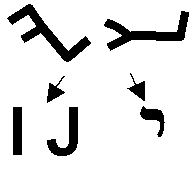The Script that went Ahead
How YaHUaH prepared the way for the Gospel in Greece and Rome
already at the time when Isra’el diverted from Him
Part II.
André H. Roosma
7 August 2015
In Part I of this article, I told the story of our (Latin) script; how in two steps it got adopted from the old
Paleo-Hebrew script that was a development of the old West-Semitic (a.k.a. Canaanite or Sinaitic) script Moses used when he
wrote the Torah.1 I expressed my awe and wonder about the observation
that God had the Greeks and then the Romans adopt it, with some minor
modifications, at the time when the northern Israelites and the Jews went
into exile, respectively. And that this script and the far-stretching Roman
empire greatly facilitated the spread of the written Gospel and the other
New Testament as well as First Testament writings...
Here a sequel of the discussion of the various letters from the aleph-bet
as Moses used it and how they were adopted into the Greek and Latin
worlds.
The development of the letter signs (continued)
Below, I will continue to illustrate how the letters of the old script
of Isra’el (top row in each picture) were
at the basis of our (Latin) letters (bottom, left), such that often our letters resemble
the old characters better than the Hebrew square script letters (bottom right) derived from Imperial Aramaic of the
sixth to fifth century BC.

The next symbol of the old Semitic script from the time of the
Patriarchs and Mosheh was a picture of either a basket or a potter’s
wheel. The art of pottery baking is already quite old. The symbol
represented clay and earth(enware), the verb to turn, and the notion of
holding, surrounding, encompassing or enclosing something.
In early Paleo-Hebrew this symbol remained almost the same. The Greeks
simplified it a little to form their theta Θ ; the Romans did not adopt it; hence the English
th now has to be written using two letters...
The Aramaeans symplified the symbol somewhat more than the Greeks.

An interesting symbol of the old Semitic script was a depiction of an
arm with an open hand. I show two variants that I encountered. It symbolized
exactly that, any branch (e.g. of a tree or a
river) and the verb to give, especially ‘he gives’.
In early Paleo-Hebrew this symbol changed little. The Greeks simplified it
considerably, while the attached thumb became a loose dot: Ι, calling it iota. The Romans called
it just plain I [pronounce: ee].
Later it diverged into both I and J. Most likely, it already had the vowel
and consonant value of these letters respecively, right from the start.
In Aramaic, the symbol got reduced even more than in Greek.

The next symbol of the old Semitic script is the kaph, depicting a
raised hand. In the course of time the arm got added to it and the hand
got simplified a little.
The Greeks adopted it rather straightforwardly, while shortening the
arm and turning it straight up and mirroring the entire symbol: Κ, calling it kappa. The Romans
adopted it as the letter K.
In Aramaic, the letter shape got simplified considerably - more than
in Greek or Latin, and split into a common and a final version.

The next symbol of the old Semitic script depicted a shepherd’s
stick; that was a long straight stick, with a circular bent at one end.
It represented any big stick and the shepherd or leader figure that
held it.
The Greeks adopted an early variant with a simplification: Λ, calling it Lambda. The Romans copied
(and mirrored) the variant as shown: L.
In Aramaic, the letter shape got changed almost beyond recognition.

In the old Semitic script the symbol for water was most natural: a wavy
line. Like water in those dry lands, it signified abundance and plurality
as well.
The Greeks and Romans adopted the symbol rather straightforwardly,
as the Greek Μ and the Latin M,
calling it mu and
em, respectively.
In Aramaic, the letter shape – especially the final variant –
got changed beyond recognition.

The old letter nun depicted a sprouting seed. Apart from just
representing seed or fruit, it also symbolized the notions of offspring
and anything that comes forth from or looks like something else. Quite
early the little ball on the one end got lost and the zigzag more
pronounced.
The Greek nu Ν, from which the Latin
N is a rather straightforward symplification and normalization of its
mirror-image.
In Aramaic, the letter shape was simplified differently and in my view
less recognizable.
In all languages it remained an important letter.

The old letter samekh or sin depicted a date palm tree.
Like the date palm itself, it symbolized also the legendary Tree of Life
and the notions of life, sustenance and support. Because a palm tree had
been used by God to reveal Himself in fire, it also represented God’s
presence. For many centuries it was the national symbol of Israel, always
drawn with three fronds on each site of the trunk and one in the middle.
The Greeks used a simplified version of this letter, consisting of the
three pairs of branches only, for the xi: Ξ, from which the Latin X emerged. Noteworthy is that
in related Old South Arabian scripts, two X-signs on top of each other, as
depiction of the pattern on a palm trunk, were already their way of writing
the samekh/sin. This may have influenced the Greek choice as well.
In Aramaic, the letter shape got changed beyond recognition.

The next old symbol represents actually two letters, in some Semitic
languages still available as ‘ayin and ghayin. The
grapheme depicted both an eye (‘ayin) and a hull eveloping something (ghayin).
The Greeks adopted the grapheme rather straightforwardly into two letters
of different size, while omitting the dot inside the circle: Ο, calling it o-micron, and Ω - o-mega - as placed on a pedestal.
The Romans adopted it as the single letter O. Both used it for
o-sounds because they did not have the Semitic sounds associated with
this letter, and Semitic did not give them another letter for the o.
In Aramaic, the letter shape got changed considerably - beyond
recognition.
< to be continued in Part III >
Hallelu YaH !
Notes
|





